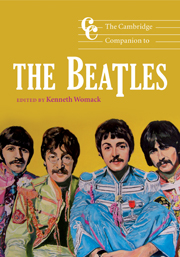Book contents
- Frontmatter
- Introducing the Beatles
- Part I Background
- Part II Works
- 3 Rock and roll music
- 4 “Try thinking more”: Rubber Soul and the Beatles' transformation of pop
- 5 Magical mystery tours, and other trips: yellow submarines, newspaper taxis, and the Beatles' psychedelic years
- 6 Revolution
- 7 On their way home: the Beatles in 1969 and 1970
- 8 Apple Records
- 9 The solo years
- 10 Any time at all: the Beatles' free phrase rhythms
- Part III History and influence
- Notes
- Beatles discography, 1962–1970
- Select bibliography
- Index
3 - Rock and roll music
from Part II - Works
Published online by Cambridge University Press: 28 September 2011
- Frontmatter
- Introducing the Beatles
- Part I Background
- Part II Works
- 3 Rock and roll music
- 4 “Try thinking more”: Rubber Soul and the Beatles' transformation of pop
- 5 Magical mystery tours, and other trips: yellow submarines, newspaper taxis, and the Beatles' psychedelic years
- 6 Revolution
- 7 On their way home: the Beatles in 1969 and 1970
- 8 Apple Records
- 9 The solo years
- 10 Any time at all: the Beatles' free phrase rhythms
- Part III History and influence
- Notes
- Beatles discography, 1962–1970
- Select bibliography
- Index
Summary
George Martin, in many ways, birthed the Beatles as we know them. We know them through their records, not their performances. They arrived on his step as a nightclub-hardened beat group with virtually no studio experience and, under his tutelage, they became the musical group that personified the studio as an instrument. The Beatles’ first three long-playing records, Please Please Me, With the Beatles, and A Hard Day's Night, were a short ramp leading up to a colossal cultural shift. Astonishingly, they were all recorded and released in a twenty-two-month period. To examine those cornerstone recordings, we must first see how they arrived there.
The first experience any of the Beatles had with recording was in 1958, when the Quarrymen, with John Lennon, Paul McCartney, George Harrison, Colin Hanton, and Duff Lowe, cut a shellac disc of two songs at a home studio in Liverpool. One was Buddy Holly and the Crickets' “That'll Be the Day,” a highly appropriate choice considering Holly's pervasive influence on the band. The other was “In Spite of All the Danger,” a McCartney- Harrison composition characterized by McCartney as “very influenced by Elvis.” To the participants, the event had a magical feel, as they now could return to their homes and play an actual performance of their own. Still, a professional studio seemed an unattainable dream, and they were barely beyond being just a scruffy little skiffle group.
- Type
- Chapter
- Information
- The Cambridge Companion to the Beatles , pp. 63 - 74Publisher: Cambridge University PressPrint publication year: 2009



